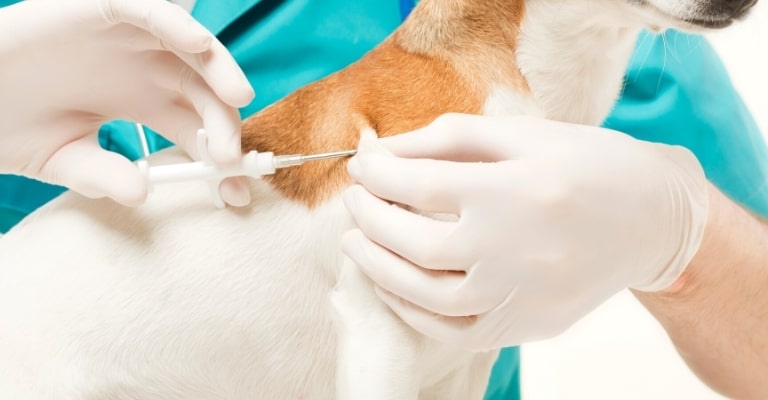Nearly 10 million pets go missing each year here in the United States. Millions of these pets end up in animal shelters, and sadly, only 15% of them are ever reunited with their owners. Microchips are used to assist in reuniting those pets with their families.
Table of Contents
Should You Microchip Your Golden Retriever?
Microchipping your dog is one of the best ways to protect them. They provide an easy way for anyone who finds your dog to contact you and help you be reunited as soon as possible. Due to the microchip being located under the skin, it is extremely difficult for your dog to lose it.
In order to improve the chances of your lost Golden Retriever being returned to you, it is important to maintain forms of identification like collars with tags that contain your contact information. Fencing and gates may prevent your dog from bolting out of the front door, but unfortunately, no system is perfect. Also, collars and tags can be easily removed. Thankfully, microchips may be the better way to protect your beloved canine companion.
What Is a Pet Microchip?
A microchip is a tiny electronic circuit that is embedded inside of a small piece of plastic. The chip itself is roughly the width of a grain of rice and is about as long as two grains of rice.
Microchips store information about the chip’s manufacturer and carry an individual identification code that is specific to just that one chip. Special scanners can detect this code by simply waving the scanner over the pet.
Identification codes may be numeric or alphanumeric, and they can vary from nine to fifteen digits in length. The microchip company will link this code to a specific pet once the microchip has been implanted and the pet’s information has been registered.
If a dog is found and a microchip is detected, the person with the scanner can call the company and work on reuniting the lost dog with his owner!
How Is a Microchip Implanted?

A microchip is implanted through the skin using a 12-gauge needle. The chip is then gently placed below the skin. A typical implant location is between the shoulder blades of a pet.
Sometimes, the chip will move away from its original location. This is why people who use microchip scanners are trained to scan the entire pet in case the chip migrated towards the neck or legs. Most chips, however, remain in place.
The initial implantation needle may hurt a little, but the pain is usually no more intense than the sensation from a vaccination needle. It may leave a tiny hole in the skin but it heals very quickly, and no special bandaging is required. Once the microchip is implanted, it does not bother the pet.
How Much Does Microchipping Cost?
Depending on where you are located, microchipping can cost anywhere from $35 to 45 dollars. This includes the cost of sending registration information to the appropriate microchip company. Some companies may ask for annual registration fees to keep your information current, so it is important to keep track of this for your dog.
If you adopted your dog from a shelter or Humane Society, it is very likely that your new friend already has a microchip present. Shelters will register the chip for you and then provide information about the microchip in your adoption paperwork. This sometimes includes a tag with the number printed on it, and the tag can be attached to the dog’s collar.
Be sure to check with your Pet Insurance provider to see if they cover some of the costs with microchipping. Many do not, however some do help with the cost.
Where Do You Microchip Your Golden Retriever?
Your veterinarian can microchip your dog for you. This can be performed at any time, meaning sedation is not necessary before administering the chip. Puppies and adults alike can be microchipped.
Since most puppies are eventually spayed or neutered, many pet owners wait until surgery time to have their dog microchipped. Surgeries are performed while the dog is sleeping under general anesthesia, and so the microchip implantation will be much easier and not as painful when given while asleep.
Is a GPS Collar the Same As Microchipping?

GPS Collars are NOT the same as microchipping your dog. While they both can be extremely useful and come highly recommended, they use different technology.
Global positioning systems (GPS) use radio signals that travel to satellites in space in order to locate a specific position anywhere around the globe. There are no microchips available with GPS technology, primarily because the chips would have to be bigger in order to facilitate this kind of function.
However, GPS technology does exist in the form of tracking devices for dogs. They run on small battery packs that attach to your Golden’s collar so that you can keep track of his whereabouts in real time if he goes missing. Some tracking devices come equipped with an application that you can download on your cell phone.
Do Microchips Hurt Dogs?
Microchipping is safe for dogs. Once implanted, it causes no pain or discomfort. There also aren’t any side effects associated with microchipping. There have been occasions where a chip stopped reading, but these are very rare. Chips are also safe in a situation where MRI testing is necessary.
There have been rare cases where a microchip was accidentally implanted into the head, but this can be avoided if the direction of the needle is towards the hind end of the dog and not the front end. There have been two cases where tumors developed in the area of the microchip, but the jury is still out on whether or not the chip was the direct cause.
Conclusion
Microchipping is a safe and effective way to protect your dog. If your Golden Retriever ever runs away or slips off his leash and escapes, having a microchip and proper identification will drastically increase his chances for a safe and quick recovery.
Another way to help with the safety of your dog is to have the proper training. Check out our guide on Training a Golden Retriever to see how you can keep your Golden safe.

